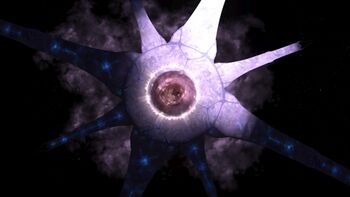Installation 00
From Halo: Daybreak
Installation 00, also known as the Ark, is a Forerunner megastructure located far outside the Milky Way galaxy. It was the strategic base-of-operations for the Halo Array, as it was the only place where new installations could be constructed, as well as coordinate the firing solutions for the entire network. However, its secondary function was also as a preservation center for live sapient species that were otherwise wiped out by the Halos, making it critical for the reseeding phase of the Conservation Measure.
History[edit | edit source]
Forerunner-Flood War[edit | edit source]
Installation 00 was constructed at some point prior to 97,445 BCE. It was a closely-guarded secret by the Forerunners, with only the highest members of the Ecumene being aware of its existence, and only the Master Builder knew of its location. It was intended only to be used as a last resort against the Flood, when there were no other options available to defeat the parasite. The Ark could be reached only by a network of portals, most of them evidently located within the protected boundary of the Jat-Krula sphere. The only portal known with certainty to have survived, however, is located on Earth, built there in the final days of the war by the Librarian.
For the latter part of the war, the Ark served as the command center for the Didact, who used it to coordinate the deployments of what remained of the Forerunner military against the Flood. Around this time, the corrupted Contender-class ancilla Mendicant Bias learned of the Ark's existence; while it did not know of its exact location, it knew that the installation could be reached via portals within the Jat-Krula sphere. In response, the Forerunners created Offensive Bias to defeat the rogue AI. In its rage against its creators, Mendicant Bias mobilized the entire might of the Flood's fleet, breaching the Line in an effort to stop the Array's firing, but Offensive Bias predicted this and lay in wait, engaging Mendicant in an immense naval battle in which the rogue ancilla was eventually defeated.
After attempts to delay the firing, the Didact begrudgingly activated the Halos from the Ark, bringing an end to the Forerunner-Flood War at the cost of all living sapient species in the Milky Way. Following this, the installation assisted the reseeding phase of the Conservation Measure, with Keyships ferrying species to and from the various homeworlds. Upon completion of this, the Ark was reduced to minimal readiness for the next 100,000 years.
Battle of the Ark[edit | edit source]
- Main article: Battle of the Ark
During the Battle for Earth during the Siege of Sol, the Covenant loyalists under the direct command of the High Prophet of Truth were successful in uncovering the Voi Excession. Using the Keyship Anodyne Spirit, they activated the portal on November 17, 2552, and immediately departed for the Ark. They were closely pursued by the Schismatics' Fleet of Retribution, who were reinforced by a small UNSC battle group.
Both the Jiralhanae-led loyalists and the Schismatic fleet arrived at the Ark on December 11, beginning the Battle of the Ark. While the two Covenant factions clashed for supremacy in orbit, with Truth's fleet beginning with a strong 3-to-1 advantage in numbers. However, the Jiralhanae's lack of experience in space combat, and also their ability to capitalize on the more advanced countermeasures they possessed, allowed the Sangheili to whittle down their enemy until the Covenant could no longer maintain a secure hold of the installation's orbit. Concurrently, both sides immediately deployed troops to fight for the Ark's surface, with the most significant fighting occurring near the Cartographer, as whoever captured the Citadel would determine the outcome of the Human-Covenant War, as they would be able to activate the Halos. Minor battles occurred elsewhere, with both Schismatic and Covenant forces fighting for control of the various Ark defense systems. This also involved a direct attack on the landed Keyship.
Although Truth was the first to gain control of the Ark's Citadel and activated the Halo's firing sequence, the Schismatic-human forces, with assistance from the newly-arrived Flood on High Charity, were able to defeat the Prophet and reverse the process. The Flood, free to spread thanks to the damage to the Ark's defense facilities in the fighting, immediately turned the allied troops. It was at this point that a new Halo - Installation 08, a replacement for the destroyed Installation 04 - was revealed to all parties. Because of its incomplete state, Thel 'Vadam and John-117 formulated a plan to use it to destroy the Flood once and for all, while the remaining UNSC and Schismatic fleets departed. Using the recently-rescued AI Cortana, Installation 08 was activated and tore itself apart, destroying the Flood and the Ark with it. This came at a cost - while Thel 'Vadam made it back to Earth on the frigate UNSC Forward Unto Dawn, half the ship was severed as the Portal collapsed, taking with it John-117.
Post-Covenant War[edit | edit source]
With the loss of the Anodyne Spirit, the Ark was practically inaccessible to any faction that wished to exploit its advanced technological resources.
The Ark attempted to repair itself, although this was slow-going and it was never going to be complete. The Halo field completely wiped out any life forms that were present on the installation, and it would never again be able to fulfil its role as a preservation sanctuary. More immediate issues with the damage to its slipspace portal equipment meant that no new raw materials could be mined or imported towards the installation, forcing the recycling of components to stabilize the facility.
Design details[edit | edit source]
The Ark was built in the shape of a flattened disk, with eight arms - four large, and four small - protruding out from this in a slightly curved fashion. The upper surface was divided into quarantined regions which were terraformed, with each playing host to a specific planetary environment encountered by the Forerunners. These ranged from deep, storm-stricken oceans, to high-rising mountain ranges, with the atmospheric content sometimes diverging significantly from the Earth analog. At the center of the Ark was an empty ring known as the Foundry, which was where the huge construction docks and refinery bays used to build Halos were located. These received their materials from a resource-rich planetoid located in the center of this space. Orbiting the installation was a small artificial star, which dimmed and moved above the Ark to simulate a day-night cycle.
Defenses[edit | edit source]
Much like the smaller Halos, the Ark possessed a large array of countermeasures and fortifications it can call upon to defend itself. In an active defense role, vast numbers of floating Sentinel factories, usually tasked with fabricating constructors, could be redeployed at troublespots to create unending swarms of armed sentinel types, ranging from the meek Protectors all the way up to the anti-starship Devastators. Quarantine barriers could be erected between the damaged walls of refugia or around key locations, which were strong enough to resist any weapon installed aboard modern capital ships. Doors made out of neutronium can be closed to block progress, while any breaches are quickly sealed with much weaker hardlight and smartmatter projectors.
There were a number of passive defense systems as well. The entire weather network could be weaponized to better fight hostiles, with storms and low-visibility blizzards being brought to bear. This also extended to the various aspects used to adjust refugia - natural disasters become commonplace, the atmosphere is remixed to make breathing difficult, and corrosive nanites are introduced into the air and sea to overcome hazardous terrain equipment. However, because these latter systems could cause catastrophic damage to the refugia's life forms, these measures are only implemented when biodiversity concerns are outweighed by immediate risk to the installation.



